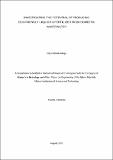| dc.description.abstract | Water bodies experience environmental challenges such as eutrophication due to poor
management of domestic wastewater in developing countries. Meanwhile, the explosion in
population of the world has resulted in a 1.8 percent annual increase in demand for fertilizers
that contain important nutrients. Although domestic wastewater contains nutrients (nitrogen,
phosphorus, and potassium) that can be used in agriculture, its recovery is still a challenge.
Some of the potential methods, such as the use of struvite precipitate in recovering nutrients
from wastewater, are not only costly but also introduce a second pollutant into the ecosystem.
The ion exchange method can recover phosphorus from wastewater; however, its
effectiveness is limited by the presence of competing anions, such as sulfates. Freeze
concentration method is one of the potential techniques for recovering nutrients from
wastewater. However, its optimal condition such as temperature and time in recovering
nutrients from domestic wastewater is not well known by researchers. In this study, method
of freeze concentration was studied to establish its optimal condition in recovering nitrate nitrogen and phosphate nutrients from domestic wastewater processed in anaerobic digester.
Frozen liquid and unfrozen concentrated liquid are produced. The effect of freezing
temperature from -10°C to -80°C, freezing time from 1 hour to 8 hours and energy
consumption on the nutrient recovery were investigated. Freezing temperature of -20°C,
cooling time of 7 hours and energy consumption of 0.197 kWh/L resulted in the highest
nitrate-nitrogen and phosphate nutrient recovery value of 1.114 and 4.667 respectively at the
inlet of anaerobic digester 1, 1.325 and 4.975 respectively at the outlet of anaerobic digester
1, 1.099 and 4.859 respectively at the inlet of anaerobic digester 2, 1.132 and 4.755
respectively at the outlet of anaerobic digester 2 and for gravel filter at the outlet the values
where 1.111 and 4.861 respectively. This study shows that, when the freeze concentration
method is used with the right temperature, time, and energy, a significant amount of nutrients
may be recovered from domestic wastewater that can be used as biofertilizer. | en_US |

